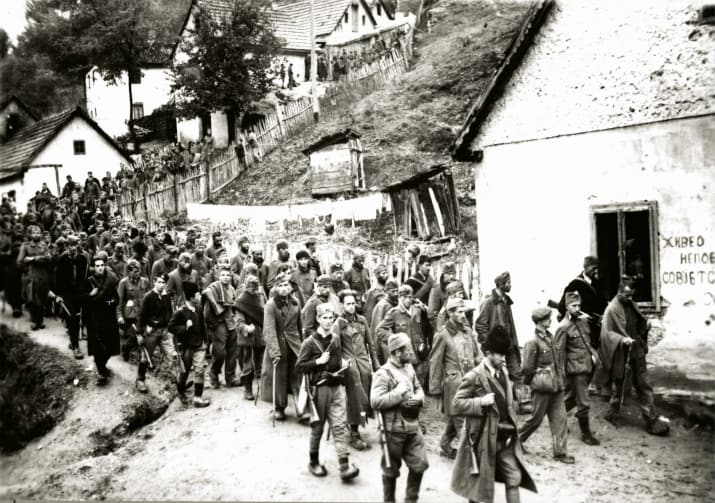
Yugoslav Jews are led to their deaths in Bulgaria. The Bulgarian government on February 22, 1943, agreed to deport Jews living in occupied Yugoslavia and Greece to German labor camps. Within a month, 23,000 Jews were rounded up, transported to Treblinka and Auschwitz in Poland and killed. For more information, click here.
By: Phil Kohn. Dedicated to the memory of his father, GM3 Walter Kohn, U.S. Navy Armed Guard, USNR, and all men and women who have answered the country’s call in time of need. Phil can be contacted at ww2remembered@yahoo.com.
On February 19, 1943, British Gen. Orde Wingate’s 3,000 Chindit guerrillas engage in their first action behind Japanese lines in Burma, cutting the Mandalay-Myitkyina rail line. The first “flight nurse” recruits of the U.S. Army Nurse Corps are certified at Louisville, Kentucky. The women’s role is to render care to wounded soldiers being evacuated by air from the front lines.
Fierce fighting continues in central Tunisia on February 20 after the German breakout through the Kasserine Pass, but further offensive operations by the Afrika Korps are called to a halt. Overextended and with his supplies dwindling, Rommel realizes that he cannot continue on the offensive; the Afrika Korps pulls back to the Kasserine Pass, in western Tunisia. The Afrika Korps will move to the heavily fortified Mareth Line, to defend against the approaching British Eighth Army. (The Mareth Line was a pre-war fortification built by France to protect Tunisia against attacks from Libya, a colony of Italy. Axis engineers had refurbished and strengthened the fortification for use during the war.) In Hollywood, executives of major motion picture studios agree to allow the U.S. Office of War Information to censor their movies.
On February 21, U.S. troops occupy Mbanika and Pavuvu, in the Russell Islands, northwest of Guadalcanal. Especially important is an airfield there. A fierce battle had been expected, but the Japanese had already withdrawn, and the islands were taken without a fight. In the Netherlands, Roman Catholic bishops protest the persecution of Jews. In the Ukraine, German forces begin an offensive towards Kharkiv.
The Bulgarian government on February 22 agrees to deport Jews living in occupied Yugoslavia and Greece to German labor camps. Within a month, 23,000 Jews are rounded up and transported to Treblinka and Auschwitz, in Poland, and killed.
The Allies on February 23 launch a massive air attack on the Kasserine Pass, driving the Afrika Korps back to its starting position. In Munich, Germany, six core members of “The White Rose” are executed by decapitation. “The White Rose” was a non-violent, intellectual resistance movement consisting of about a dozen students at the University of Munich and their philosophy professor. The group became known — and arrested by the Gestapo — for its anonymous leaflet campaign that called for active opposition to the Hitler regime. In the U.S., the government begins minting “steel pennies” in an attempt to conserve copper for the war effort; the one-cent coins are zinc-plated to prevent rust. They are generally unpopular, however, as they are frequently mistaken for dimes, and they don’t work in vending machines equipped with magnets to catch slugs.
By February 24, after five days of attacks, Allied convoy ON-166 — sailing from Liverpool, England, to New York City — has lost 15 of its 49 ships. Only one German submarine is sunk by convoy escorts. In Tunisia, the Allies retake the Kasserine Pass.
On February 25, a round-the-clock bombing campaign over Germany begins: U.S. Army Air Forces planes bomb during the day, and RAF planes bomb at night. Over 2,000 raids are conducted over the next 48 hours. Relations between the Allies become tense as the London-based Polish government-in-exile states its expectation that the Soviet Union will restore Poland’s pre-war eastern frontier. The statement is made in protest over Soviet decisions negatively affecting Polish sovereignty over eastern territories and the rights of Polish citizens there.



